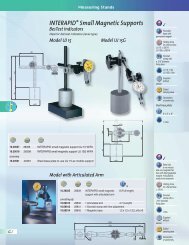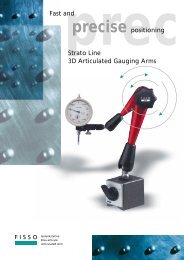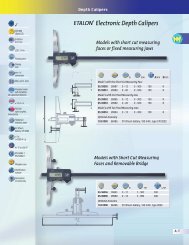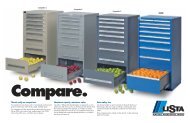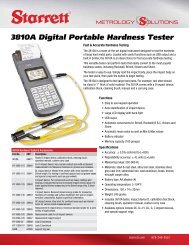how it works - Swiss Instruments Ltd
how it works - Swiss Instruments Ltd
how it works - Swiss Instruments Ltd
Create successful ePaper yourself
Turn your PDF publications into a flip-book with our unique Google optimized e-Paper software.
By Barbara Donohue<br />
<strong>how</strong> <strong>it</strong> <strong>works</strong><br />
h o w i t w o r k s<br />
A cutting oil from<br />
Hangsterfer’s Laboratories.<br />
(Photo courtesy of Hangsterfer’s<br />
Laboratories, Inc..)<br />
50 Today’s Machining World
Cutting<br />
fluids<br />
Choose the right oil or cutting fluid to improve tool life,<br />
surface finish and cycle times.<br />
Unless you’re doing dry machining, you’ll use some<br />
kind of cutting oil or fluid in your machines. Cutting<br />
fluids and oils provide lubrication and cooling. They<br />
also help remove chips from the cutting area.<br />
Selecting from the hundreds of available cutting fluids<br />
can be a real challenge. Experts in the business offer some<br />
guidelines on selecting and maintaining this important part<br />
of the machining process. Usually, you’ll choose e<strong>it</strong>her a<br />
straight oil or a water-miscible (dilutable) fluid.<br />
Straight oils<br />
These are “mineral oils,” petroleum products made from<br />
crude oil. Straight oils offer the maximum amount of<br />
lubrication, and the least cooling capac<strong>it</strong>y. Blended w<strong>it</strong>h<br />
add<strong>it</strong>ives to improve performance, these oils are often used<br />
in screw machines and in heavy cutting operations like<br />
broaching and gun drilling.<br />
Vegetable oils can be used instead of, or in add<strong>it</strong>ion to,<br />
mineral oils in many applications. They tend to have better<br />
lubricating qual<strong>it</strong>ies, and higher flash point, which is the<br />
temperature at which their vapor will ign<strong>it</strong>e. In one cutting oil<br />
product line, for example, the flash points range from 200F to<br />
over 460F, w<strong>it</strong>h the vegetable oils on the higher end.<br />
Water-miscible fluids<br />
In add<strong>it</strong>ion to straight oils, three kinds of water-miscible<br />
cutting fluids are widely used. They give good tool life and<br />
help to produce a good surface finish, said Randy Templin,<br />
vice president, Blaser <strong>Swiss</strong>lube, Goshen, N.Y., a manufacturer<br />
of cutting oils and fluids. When properly mixed, the fluid is<br />
mostly water, w<strong>it</strong>h a few percent of the fluid concentrate,<br />
which is made up of oil and/or synthetics, plus add<strong>it</strong>ives.<br />
Soluble oil: This is oil dispersed in water, making a<br />
milky-looking mixture. It offers the greatest amount of<br />
lubrication among the water-miscible fluids. Emulsifiers<br />
and surfactants let the oil mix w<strong>it</strong>h the water and remain<br />
stable desp<strong>it</strong>e contamination from tramp oil, machining<br />
fines, and other materials that find their way into machine<br />
sumps, Templin said.<br />
Synthetics: These don’t contain oil. They are made up<br />
of various chemical compounds such as phosphate esters.<br />
Synthetics fully dissolve into water. They are often transparent<br />
and may look like water or have a colorant added. They tend<br />
to be the most stable of the water-miscible fluids, and are<br />
often used for applications such as fine grinding, where a fluid<br />
is needed to keep the wheel open and clean, according<br />
to Templin.<br />
Semi-synthetics: These blend oil and synthetics to give a<br />
combination of lubrication, stabil<strong>it</strong>y and cooling performance.<br />
The concentrate usually contains 30 percent, or less, of mineral<br />
oil, Templin said.<br />
Finding the right oil or fluid for your application<br />
“We’re trying to change the [industry’s] view,” said Templin,<br />
“so people think of coolant or cutting oil as part of the cutting<br />
tool package, [something that] can improve the performance of<br />
any tool.”<br />
There are so many products available and so many different<br />
h o w i t w o r k s<br />
July 2008<br />
51
h o w i t w o r k s<br />
A magnetic filter element s<strong>how</strong>ing fines collected from fluid,<br />
after conventional filtration. (Photo courtesy of Knoll America)<br />
Blasogrind cutting fluid. (Photo courtesy of Blaser <strong>Swiss</strong>lube)<br />
Vascomill, a vegetable-based cutting oil from Blaser <strong>Swiss</strong>lube.<br />
(Photo courtesy of Blaser <strong>Swiss</strong>lube)<br />
applications that you will probably depend on your coolant supplier<br />
to help you select which fluid to use. Even if you are happy<br />
w<strong>it</strong>h your current cutting fluid, there may be room for<br />
improvement. In many shops, “If tool life is reasonable,<br />
they don’t know their coolant [isn’t] optimized,” said Joe Gentile,<br />
product manager at Hangsterfer’s Laboratories, Inc.,<br />
Mantua, N.J.<br />
“The first thing I ask is: what is the primary material that<br />
the shop runs? Then, what is the secondary material,” said<br />
Gentile. Most shops specialize and don’t realize <strong>it</strong>, he said. Which<br />
machining and other processes is the shop running? Heavy cutting?<br />
Grinding?<br />
Gentile also determines what the shop’s tolerance is for<br />
residues on parts and machines. “Some shops want the<br />
machine to look like you could eat off <strong>it</strong>; some just want the<br />
tool lubricated,” he said. Also, medical and other cr<strong>it</strong>ical parts<br />
shouldn’t accumulate any residue.<br />
Your supplier will likely ask what kind of problems you’re having.<br />
Maybe you are not be getting the kind of tool life you expect.<br />
Maybe “the current product is going sour, having<br />
biostabil<strong>it</strong>y problems, smoking, misting, leaving residues, or<br />
[making operators’] skin break out,” said Mark Goedtel,<br />
product manager at Valen<strong>it</strong>e LLC, Madison Heights, Mich., a<br />
manufacturer of cutting fluids and tools.<br />
From this and other information, your supplier will select a<br />
fluid that meets the needs of your primary application, <strong>works</strong><br />
effectively w<strong>it</strong>h secondary materials and operations, and is<br />
compatible w<strong>it</strong>h any post-machining processes.<br />
Give <strong>it</strong> a try<br />
Testing a new coolant is a big comm<strong>it</strong>ment. “An insert is easy<br />
to put in a machine and test,” said Gentile. “Coolant is a different<br />
story.” You have to empty and clean the machine, he said, and<br />
you’ll need to be running the same part w<strong>it</strong>h both fluids, so you<br />
can compare performance.<br />
W<strong>it</strong>h a fluid better matched to your process, you stand to gain<br />
improved tool life, better surface finish, and reduced cycle times.<br />
You may even be able to reduce your per-tool cost, as well. “We’ve<br />
helped customers using a $100 drill go to a $20 drill w<strong>it</strong>h the same<br />
tool life,” Templin said. You can’t always go from carbide tools to<br />
high speed steel, he said, but the right cutting fluid in the right<br />
s<strong>it</strong>uation can sometimes make this possible.<br />
Goedtel told about a company that was bar peeling, a very<br />
aggressive machining process. However, the shop was using<br />
a full-synthetic water-miscible coolant, normally intended for<br />
lighter duty. This produced lots of steam and mist. Coolant usage<br />
52 www.todaysmachiningworld.com
<strong>how</strong> <strong>it</strong> <strong>works</strong><br />
was high – about one drum per day – and tool life was poor.<br />
To get acceptable performance w<strong>it</strong>h the full-synthetic, the<br />
shop was running <strong>it</strong> at 25 percent concentration instead of<br />
the usual 5 percent. Valen<strong>it</strong>e provided a semi-synthetic that<br />
added lubrication, improved tool life and reduced misting,<br />
steam, and fluid loss.<br />
When you change to a new cutting fluid, <strong>it</strong> needs be<br />
compatible w<strong>it</strong>h all of your machining processes, but don’t<br />
forget what happens after machining. Verify that your cleaning<br />
process <strong>works</strong> w<strong>it</strong>h <strong>it</strong>, and be sure to alert your plating<br />
or paint shop. The new fluid may leave different residues for<br />
them to deal w<strong>it</strong>h. For medical and other cr<strong>it</strong>ical applications,<br />
alert your customers well in advance of the change, as they<br />
may need to obtain regulatory approval.<br />
Mostly water<br />
Since water-miscible fluids are mixed w<strong>it</strong>h about 95<br />
percent water, you should have your tap water tested before<br />
selecting a new water-miscible fluid. The minerals in hard<br />
water can cause a problem w<strong>it</strong>h residues, and chemically<br />
softened water may tend to cause excessive foaming. Your<br />
cutting fluid supplier can advise you, and has different<br />
versions of product to alleviate some water-qual<strong>it</strong>y problems.<br />
gested Bill Cruey, problem solver w<strong>it</strong>h Knoll America,<br />
Madison Heights, Mich., a supplier of liquid coolant<br />
equipment. Let <strong>it</strong> stand a few days. The solids will settle to<br />
the bottom, and the tramp oil may float to the top. Cruey<br />
also suggests tying a magnet on a string and leaving <strong>it</strong> in<br />
the sump for a few hours. If you’ve been cutting magnetic<br />
materials, the magnet will come out w<strong>it</strong>h a fur of tiny metal<br />
fragments.<br />
Be particular<br />
Many different kinds of filtration equipment are available<br />
for solids removal. Nowadays, <strong>it</strong> is common to filter out<br />
particles down to 30 microns (about 0.001”). However, as<br />
shops keep fluid in service longer, smaller particles, “micro<br />
fines” accumulate more. They can cause wear on the tool, and<br />
clog through-the-tool coolant passages. If you’re running a<br />
high-pressure coolant pump, <strong>it</strong>’s a good idea to filter down to<br />
5 or 10 microns.<br />
Tramp oil<br />
Hydraulic oil and lubricant from the machine ways can<br />
end up in the cutting fluid. This can interfere w<strong>it</strong>h the fluid’s<br />
performance. “Even a couple of percent of tramp oil can make<br />
a big difference,” Templin said.<br />
W<strong>it</strong>h synthetic water-miscible fluids, often the tramp oil<br />
will float to the top when the machine is idle over the weekend,<br />
and you can vacuum <strong>it</strong> up on Monday. A coalescing un<strong>it</strong><br />
can also remove the tramp oil.<br />
In soluble oil or semi-synthetic coolants, the tramp oil can<br />
be more difficult to separate, Friedman said, so you may<br />
need something like a centrifuge to do the job. His and other<br />
companies can evaluate a sample of your cutting fluid and<br />
determine <strong>how</strong> best to deal w<strong>it</strong>h tramp oil and other filtration<br />
issues.<br />
Concentration<br />
Water evaporates continually, so you’ll need to mon<strong>it</strong>or<br />
the concentration of water-miscible fluids and keep them at<br />
their optimum concentration. You can check this yourself<br />
w<strong>it</strong>h a device called a refractometer, available from your<br />
supplier. Some suppliers will analyze samples for you.<br />
Goedtel says Valen<strong>it</strong>e performs monthly analysis for<br />
customers as part of product support.<br />
pH<br />
Another part of maintenance is mon<strong>it</strong>oring the pH.<br />
This is an indicator of the cutting fluid’s “health.” Fluid<br />
tends to go acidic when there is a problem. If the pH is<br />
out of range, you can run the sump low and add fluid to<br />
<strong>it</strong>, or if the coolant is old, you should probably change <strong>it</strong><br />
out. In a central cutting fluid system, you might add a<br />
pH adjuster.<br />
Keeping your cutting fluids on the job<br />
As the price of crude oil goes up, and waste disposal<br />
rates rise, the lifetime cost of your cutting fluids goes up,<br />
as well. In the past, a shop may have routinely changed<br />
out the coolant every year or even every six months; now<br />
they’ll try to keep the fluid going as long as possible. This<br />
requires careful mon<strong>it</strong>oring and maintenance, but can pay<br />
off in the long run.<br />
“The cost of coolant [concentrate might be] $20 per<br />
gallon,” said Steven Friedman, president of Sanborn<br />
Technologies, Walpole, Mass., a manufacturer of separation<br />
equipment for industrial applications. Then you mix water<br />
and concentrate in a ratio of 20 to 1. Now, from one gallon<br />
of concentrate, you have 20 gallons of waste to dispose of. It<br />
may cost you 50 cents per gallon, he said, to have <strong>it</strong> hauled.<br />
“Cutting fluids are much better today than in the past,”<br />
said Friedman. “They last longer and do more of what customers<br />
want.” But to keep them going, you need to do some<br />
housekeeping – remove solids and tramp oil, and mon<strong>it</strong>or<br />
the concentration and pH of the fluid.<br />
To get a feel for the cond<strong>it</strong>ion of your cutting fluid, filling<br />
a small bottle w<strong>it</strong>h clean fluid from a machine sump, sugh<br />
o w i t w o r k s<br />
July 2008<br />
53
Microorganisms<br />
Water-miscible cutting fluids offer a friendly environment to<br />
bacteria and fungi: warmth, moisture, nutrients. Overgrowth of<br />
the wrong microbes can make the fluid smell very bad.<br />
Fluid manufacturers have a number of ways to prevent this.<br />
They can formulate the fluid so <strong>it</strong> provides very l<strong>it</strong>tle nutrient<br />
material, reducing growth of the germs. Or they can add a<br />
biocide that kills any microbes present. This could eventually<br />
result in the microbes becoming resistant to the biocide.<br />
Another approach is to provide cond<strong>it</strong>ions in the cutting<br />
fluid that allow friendly, harmless bacteria to thrive, which<br />
keep the “bad bugs” from growing out of control, Templin<br />
explained. His company’s Blasocut product line uses this<br />
method.<br />
Filter, clean and recycle<br />
You can use a movable filtration un<strong>it</strong>, which wheels up to<br />
the machine, such as the portable filtration cart available from<br />
Knoll America. This un<strong>it</strong> incorporates a bag filter and/or a<br />
magnetic filter, and can remove particulates down to 5 microns<br />
(about 0.00002”). It sells for about $7,500, according to Cruey.<br />
This type of un<strong>it</strong> draws fluid from the machine sump, filters <strong>it</strong><br />
Looking for<br />
Top Performers<br />
Respected Multi-State<br />
Machine Tool Distributor<br />
has Immediate Openings for<br />
Highly Motivated and Qualified<br />
Engineers for Programming, Service,<br />
and Support of Highest Qual<strong>it</strong>y<br />
<strong>Swiss</strong> CNC Lathes.<br />
Strong Desire to Learn, Combined w<strong>it</strong>h<br />
Strong Work Ethic and a Pos<strong>it</strong>ive Can-Do<br />
Att<strong>it</strong>ude are a Prerequis<strong>it</strong>e.<br />
East and West Coast Pos<strong>it</strong>ions Available<br />
Excellent Compensation Packages<br />
Please send resumes to<br />
top_swiss_performer@yahoo.com<br />
<strong>how</strong> <strong>it</strong> <strong>works</strong><br />
and returns <strong>it</strong> to the sump. Portable tramp oil removers are<br />
also available.<br />
To clean the fluid even more thoroughly, you may want<br />
to invest in a self-contained recycling un<strong>it</strong>. These remove<br />
tramp oil and thoroughly filter the fluid. Such a un<strong>it</strong> might<br />
cost $100,000, Friedman said. “The important thing is:<br />
the fluid is expensive to use and expensive to dispose of,<br />
so buying a qual<strong>it</strong>y recycling system [can] save money<br />
in the long run.”<br />
You need to remove the fluid from the machine, said<br />
Friedman, take <strong>it</strong> somewhere and clean <strong>it</strong>. At the same time,<br />
you can clean the sump. “The right way to do this is on<br />
a scheduled basis,” Friedman said, ideally once a month.<br />
Vacuum out the coolant from the machine tool sump and<br />
take <strong>it</strong> to your recycling system. Then you can immediately<br />
refill the sump w<strong>it</strong>h fresh or recycled fluid and start making<br />
parts again.<br />
“The metalworking fluid in your facil<strong>it</strong>y is the only<br />
thing that touches every tool, every part, every person,”<br />
said Templin. You handle <strong>it</strong>. You breathe the mist. It<br />
affects every cut and every person who walks in the door,<br />
including your customers.<br />
Experts consider the fluid to be as much a part of the<br />
machining process as the workpiece and the cutting tool.<br />
And the right fluid, properly maintained, can help keep<br />
your machines producing high qual<strong>it</strong>y parts, economically,<br />
w<strong>it</strong>h optimum cycle times.<br />
For more information<br />
Contributors to this article:<br />
Cutting fluids:<br />
Blaser <strong>Swiss</strong>lube: www.blaser.com<br />
Hangsterfer’s Laboratories:<br />
www.hangsterfers.com<br />
Valen<strong>it</strong>e LLC: www.valen<strong>it</strong>e.com<br />
Filtration and recycling systems:<br />
KNOLL America:<br />
www.knollamerica.com<br />
Sanborn Technologies:<br />
www.sanborntechnologies.com<br />
Today’s Machining World





